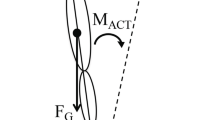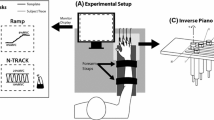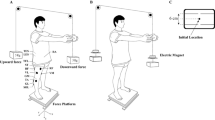Summary
The aim of the present study was to investigate postural adjustments and positional stability in a bimanual unloading task, involving essentially the index finger, in order to test whether proactive adjustments are also observed in distal body segments. A second goal of the study was to evaluate the concept of a central command that would be responsible for coupling movement and posture. The positional disturbance of the right load-bearing index finger of healthy human subjects was studied under two types of manipulations: passive, i.e., imposed, unloading and active unloading, by the subject's left index finger. It was found that, in such a distal task, positional stabilization of the load-bearing finger was much better (by a factor of 6) in the active situation than the passive situation. This improvement was greater than previously reported for a proximal task. An electromyogram (EMG) analysis of the mostly implicated dorsal interosseous muscles revealed a typical unloading reflex in the passive situation (reactive mode) and a suppression of EMG before unloading onset in the active situation (proactive mode). Averaged records showed an almost perfect synchronization between the EMG suppression in the load-bearing interosseous muscle and the onset of the EMG burst of the unloading index finger. A trial-by-trial analysis, however, revealed a considerable scatter in intervals of the two EMG events, with a tendency of the activity burst in the left finger to occur slightly before the suppression of EMG in the load-bearing muscle. No positive correlation was found between the precision of synchronization (intervals near zero time) and the accuracy of performance, i.e., positional stability of the unloaded finger. Although the trial-by-trial variability was large, it is suggested that at least some of this variability is caused by a nonsteady state of motoneuronal excitability. In view of the low-pass property of the muscle, the observed variability in synchronization may be sufficiently precise to maintain the hypothesis of a central temporal coupling of the events in the two hands through a common command. However, the lack of a correlation between the degree of synchronization and the performance in stability argues rather in favor of separate commands to the two hands that select the parameters in the spatial domain. Finally, an intermanual EMG or torque analysis is proposed that might be useful in assessing the accuracy in goal achievement, i.e., the maintenance of a stable finger position in spite of the “internal” perturbation.
Similar content being viewed by others
References
Bazalgette D, Zattara M, Bathien N, Bouisset S, Rondot P (1986) Postural adjustments associated with rapid voluntary arm movements in patients with Parkinson's disease. Adv Neurol 45: 371–374
Dufossé M, Hugon M, Massion J (1985) Postural forearm changes induced by predictable in time or voluntary triggered unloading in man. Exp Brain Res 60: 330–334
Forget R, Lamarre Y (1990) Anticipatory postural adjustment in the absence of normal peripheral feedback. Brain Res 508: 176–179
Gahéry Y (1987) Associated movements, postural adjustments and synergies: some comments about the history and significance of three motor concepts. Arch Ital Biol 125: 345–360
Gurfinkel VS, Elner AM (1988) Participation of secondary motor area of the frontal lobe in organization of postural components of voluntary movements in man (in Russian). Neirofiziologiia 20: 7–14
Hess WR (1943) Teleokinetisches und ereismatisches Kräftesystem in der Biomotorik. Helv Physiol Pharmacol Acta 1: C62-C63
Hess WR (1981) Biological order and brain organization. In: Akert K (eds) Selected works of W.R. Hess. Springer, Berlin Heidelberg New York, pp 265–268
Houk JC, Rymer WZ (1981) Neural control of muscle length and tension. In: Brooks VB (ed) Handbook of physiology (vol 2, part 1). Am Physiol Soc pp 257–323
Hugon M, Massion J, Wiesendanger M (1982) Anticipatory pos- tural changes induced by active unloading and comparison with passive unloading in man. Pflügers Arch 393: 292–296
Johansson RS, Westling GR (1988) Programmed and triggered actions to rapid load changes during precision grip. Exp Brain Res 71: 72–86
MacNeilage PF (1990) Grasping in modern primates: the evolutionary context. In: Goodale MA (ed) Vision and action: the control of grasping. Ablex, Norwood, NJ pp 1–13
Massion J (1992) Movement, posture and equilibrium: interaction and coordination. Prog Neurobiol 38: 35–56
Massion J, Viallet F, Massarino R, Khalil R (1989) La région de l'aire motrice supplémentaire est impliquée dans la coordination entre posture et mouvement chez l'Homme. C R Acad Sci [III] 308: 417–423
Nashner LM, Shumway-Cook A, Marin O (1983) Stance posture control in select groups of children with cerebral palsy: deficits in sensory organization and muscular coordination. Exp Brain Res 49: 393–409
Paulignan Y, Dufossé M, Hugon M, Massion J (1989) Acquisition of co-ordination between posture and movement in a bimanual task. Exp Brain Res 77: 337–348
Rogers MW, Kukulka CG, Soderberg GL (1987) Postural adjustments preceding rapid arm movements in parkinsonian subjects. Neurosci Lett 75: 246–251
Schmidt RA, Zelaznik H, Hawkins B, Frank JS, Quin JT (1979) Motor output variability: a theory for the accuracy of rapid motor acts. Psychol Rev 86: 415–449
Viallet F, Massion J, Massarino R, Khalil R (1987) Performance of a bimanual load-lifting task by parkinsonian patients. J Neurol Neurosurg Psychiatry 50: 1274–1283
Viallet F, Massion J, Massarino R, Khalil R (1992) Coordination between posture and movement in a bimanual load-lifting task: putative role of a mesial region including the supplementary motor area. Exp Brain Res 88: 674–684
Author information
Authors and Affiliations
Rights and permissions
About this article
Cite this article
Kaluzny, P., Wiesendanger, M. Feedforward postural stabilization in a distal bimanual unloading task. Exp Brain Res 92, 173–182 (1992). https://doi.org/10.1007/BF00230393
Received:
Accepted:
Issue Date:
DOI: https://doi.org/10.1007/BF00230393




